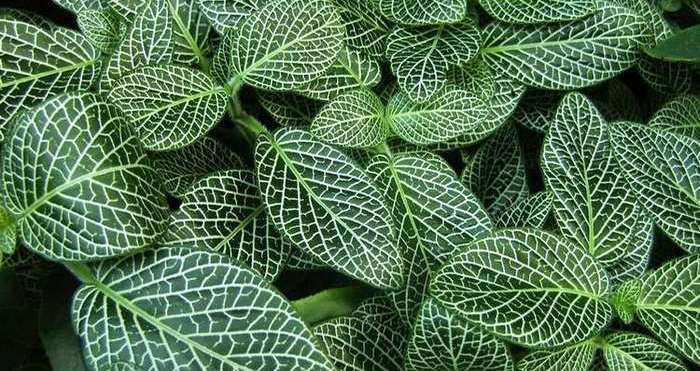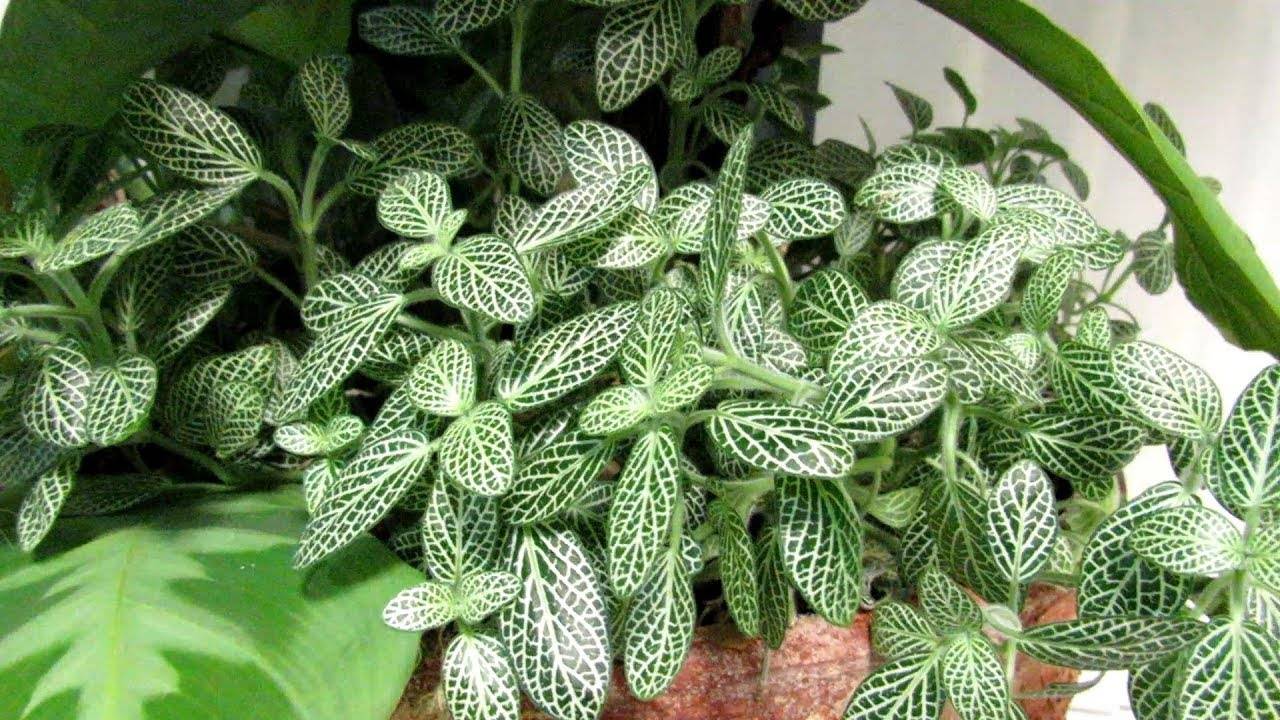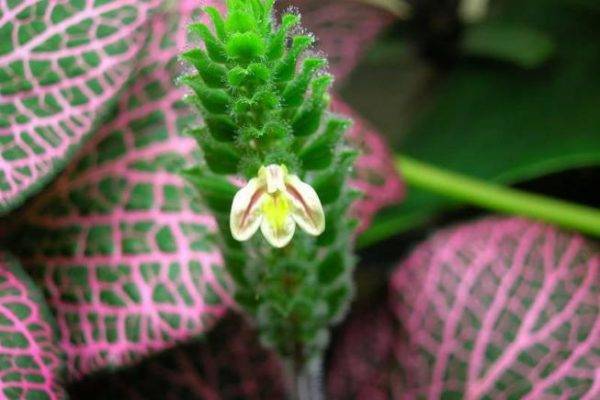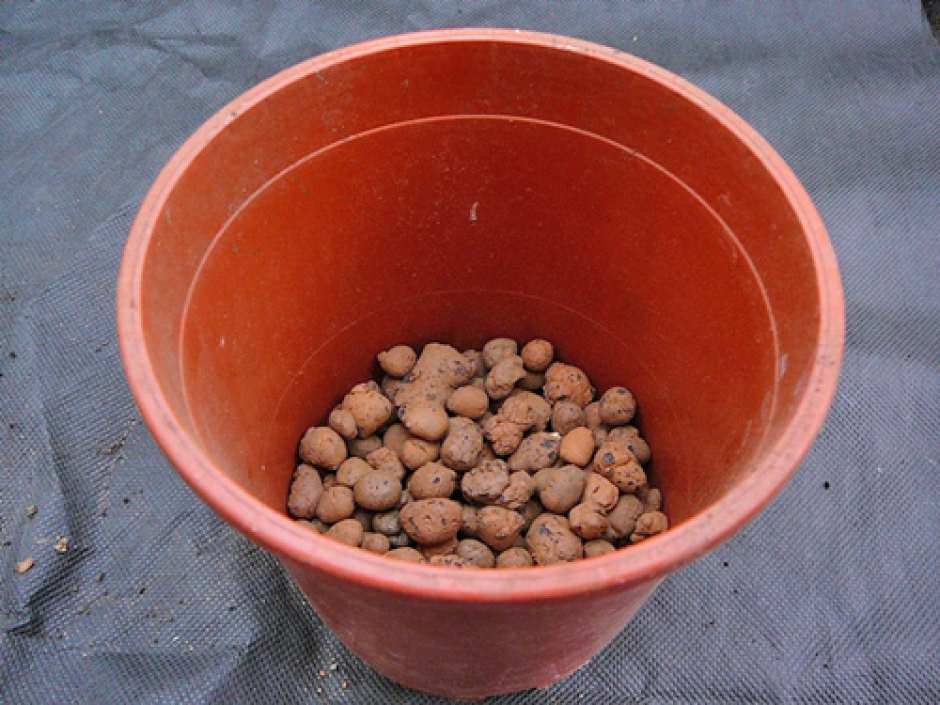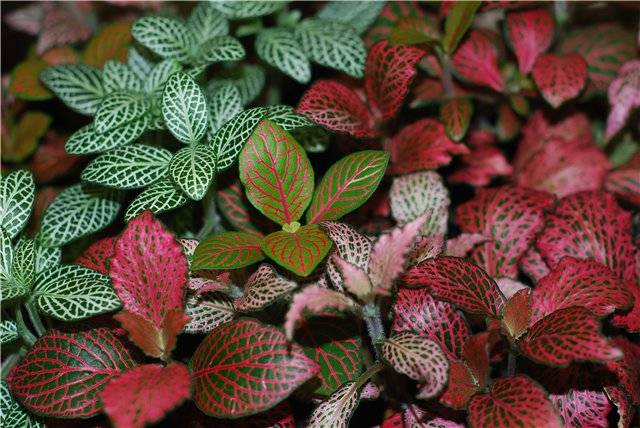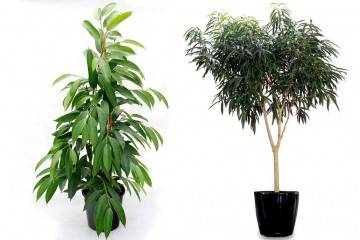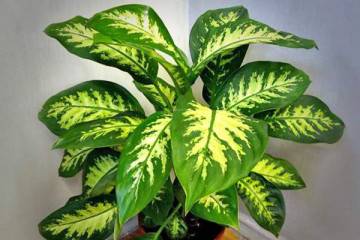Fittonia flower - home care
Content:
Fittonia is a small ornamental plant. It has gained popularity among flower growers due to its unusual foliage. There are several types and varieties that differ in the shade of the color plate and the pattern of veins that stand out clearly on them.
Fittonia appearance
Fittonia (Fittonia) is a perennial plant, the birthplace of which is considered to be South America. It belongs to the Acanthus family, whose representatives mainly grow in tropical countries. It is a short shrub with small yellowish flowers. The stems usually do not grow more than 10 cm and are densely pubescent. It changes depending on the age of the flower.
Common varieties
The varieties are distinguished by shades of veins that cover the leaves with a dense network. They are not similar not only in size, but also in color. The description will help to present unusual tropical shrubs in all their glory:
- fittonia Skeleton. Velvet light green leaves are dotted with bright red lines. A clear contrast creates a glowing effect, the plant seems to remain visible in the dark;
- fittonia nana. It differs in small leaves, the length of which does not exceed 2.5 cm. The veins are light, several shades behind the color of the plate itself;
- fittonia Josan. The color plate is emerald, and the mesh of lines is bright pink. Its edge is dark green, it seems that the border is completely black;
- fittonia red. The leaves have a dark emerald hue. Due to the red veins, they are perceived as black. Such a contrast creates the effect of volume, it seems that the leaves are convex;
- Fittonia White Anna. She looks snow-white due to the many veins. A dark green edging is visible along the edges of the leaves;
- fittonia white is distinguished by the absence of a border, and the threads of the veins are thicker and denser, slightly convex;
- Mix. This is a group consisting of several varieties of Fittonia. It amazes with its colorfulness and dissimilarity to other mixes. The color of the leaves varies from light green to dark. Veins set off them, adding variety;
- miniature fittonia. It has small leaves that differ in all sorts of tones. The veins are so densely packed that they merge. This makes Fittonia leaves appear to be red, pink, or pale green.
Also at home, Vershaffelt Fittonia is bred with olive leaves and a dense network of pink veins, they can be white or scarlet.
Features of home care
To maintain a bright and lush fittonia, home care is not considered time-consuming and too burdensome.
The health of the flower will affect the well-being of the household, because fittonia purifies the air, helps to relax and fall asleep. These beneficial properties make the plant an even more valuable guest in any home. It is considered a symbol of change, therefore it is presented to people who are confused in life, because it sets them up to search for non-standard solutions.
Temperature
The type and variety of the plant does not affect home care, fittonia Josan, red, white require the same rules. A tropical flower loves warmth. In summer, he is comfortable at a temperature of 24-25 ° C. In winter, it is better that the thermometer does not drop below 20 ° C.
Lighting
Fittonia loves sunlight, but it should be diffused. Otherwise, the wonderful pattern on the leaves will wear off and disappear. The foliage will acquire a uniform nondescript color. The ideal position is windows on the east or west side.
The plant reacts quickly to the sun, so you can tell by its appearance whether it lacks light or not. So, through trial and error, it will be possible to find a comfortable place.
Watering
You need to water the plant depending on the conditions in the room. The main thing is not to allow the earth to dry out completely. Fittonia instantly reacts to this by shedding leaves. Waterlogging also leads to problems, it can cause root rot. Therefore, you need to find a middle ground by providing comfortable watering:
- moisturize the soil often and abundantly in summer;
- gradually reduce the frequency in the fall;
- in winter, a couple of days after the soil has dried.
Spraying
It is recommended to spray constantly. Fittonia does not tolerate dry air. You need to carry out the procedure 1-2 times a day. It is recommended to use soft water at room temperature.
Humidity
High humidity is a prerequisite for keeping a flower.
How to care for Fittonia if the air at home is dry:
- put the pot in a container with wet expanded clay. It can also be replaced with pebbles or moss;
- make sure that water does not get inside the pot through the bottom hole, does not come into contact with the ground;
- place heaters away from fittonia. She also dislikes close proximity to the battery.
Priming
The soil for fittonia needs loose, without clay impurities. It should not form lumps and stick together. Therefore, in addition to leafy soil, peat and sand should be present in it.
You can make a mixture of:
- coconut substrate;
- bark of coniferous trees;
- sand;
- garden land.
Top dressing
Fittonia is a delicate sensitive plant. Fertilizers he needs 2-3 times less than other indoor flowers. They are fed from the beginning of April to August using liquid complexes intended for decorative representatives of the flora.
Features of winter care
In winter, the plant should be placed on the south window to provide sunlight. If the lighting turns out to be insufficient, the leaves become pale, then it is worth strengthening it artificially. The temperature must be kept at least 19-20 ° С.
When and how it blooms
Fittonia is a flowering plant, but unusual leaves make it attractive. It was thanks to them that the plant gained popularity.
How Fittonia blooms:
- the period takes a long time, but is of no value, lasts from summer to mid-autumn;
- flowers in ears, they are small and pale yellow. They do not smell and do not attract attention. Peduncles are light green and grow from leaves.
Flowering care
Special care of Fittonia during the flowering period is not required. It practically does not affect the appearance of the plant.If the period does not come, people do not even think why this is happening. Therefore, even if flowers do appear, they are often simply plucked to save energy and direct them to the growth of attractive leaves.
Pruning
Fittonia is a perennial flower, but after a certain time, the lower part of the shoots loses leaves and becomes bare. Because of this, the plant looks careless, unkempt. Therefore, periodically you need to pinch the tops of the stems, which can be planted. This procedure is called rejuvenation. Thanks to her, the tropical flora looks good and continues to delight the eye. Fittonia begins to branch out, acquiring volume, splendor and attractiveness. But you cannot immediately remove the shoots, it is important to leave the leaves. Therefore, it is recommended to carry out rejuvenation in several stages.
Reproduction
Together with rejuvenation, plant propagation can be carried out. It is advised to do it annually. Therefore, every spring material appears for transplanting Fittonia. Then the cuttings method is applied. In addition, the plant can multiply by dividing the bush and air layers.
Rooting cuttings
Cuttings are cut from the top of the plant in early spring. It is necessary that their length be about 8 cm, and they have at least 3 sheets, as much as possible. Shoots for propagation must be left exceptionally healthy.
Rooting takes place according to the following plan:
- The cuttings are planted in the sand.
- Cover with a jar, creating greenhouse conditions.
- Young shoots are periodically ventilated and watered.
The process will end in a month. You can root in water by placing the cuttings in a jar. To speed up the process, you need to cover it with a bag or wrap it with foil. Young plants should be opened once a week, giving access to fresh air. At this time, you need to moisten the shoots by spraying. When the roots appear, it remains to plant the cuttings in a loose, slightly acidic soil.
Air layering
Air layers can form on their own. But a florist can also help with this:
- Part of the shoots without leaves bends towards the ground.
- Sprinkle with soil suitable for the plant.
- After the roots appear, the branch is cut off and planted in a separate container.
Dividing the bush
Dividing a bush is an easy way, but it requires accuracy. It is important not to damage the roots of the plant. The method allows you to get rid of diseased and injured parts of the cuticle. If rotting has begun, you can eliminate the damaged roots, which will save the flower from death.
Fittonia is watered abundantly a day before the procedure so that it can be easily removed from the pot. After that, they are divided into two or three parts and seated in different containers.
Transfer
Fittonia is recommended to be replanted in early spring. At the same time, pots are chosen that are wide, but not deep. The root system of the plant is located close to the surface, it does not require much space. Be sure to place drainage on the bottom of the container, expanded clay, small pebbles or broken brick will do. The main thing is to ensure the permeability of air and moisture.
Fittonia is a fragile flower; it must be handled with care so as not to damage the stems and roots. When removing from the pot, it is recommended to use the transshipment method, gently tapping on the container to help the earth move away from the walls. Loose soil should be moistened beforehand to make it viscous. When transplanting, it is worth examining the roots for damage and disease. If necessary, remove the part.
Once purchased, the plant requires an annual transplant until it reaches the age of five. Adult Fittonia in spring can only be pruned by rejuvenation. It is recommended to transplant such an instance once every two to three years.
Pests and diseases
Fittonia can be affected by the following pests:
- shield. Insects drink the sap of the plant, which causes it to wilt and develop brown spots. They are visible on stems and leaves. Getting rid of them is not difficult. You need to wipe the affected areas with soapy water;
- mealybug. White lumps resembling dirty cotton wool are clearly visible on the leaves. A shower will help cure the flower, which will wash away the traces of parasites. Then the plant must be sprayed with soapy water with the addition of alcohol. Also, olive oil is dissolved in water and the leaves are treated. If the lesion is severe, chemicals must be used;
- spider mite. It appears when there is a lack of moisture, dry air is a prerequisite for insect damage. A cobweb woven by a small red insect is visible under the leaves, and whitish spots appear on the surface. It is recommended to process the flower with actellik. It is a broad-spectrum insecticide that is actively used by flower growers.
The appearance of a plant speaks of its condition. So, yellowish or brown leaf tips appear when the air is dry. Also, this condition is possible if the flower lacks nutrients. It is necessary to feed the plant with a special fertilizer. If the leaves are lethargic, although watering is timely, root rotting began. This is due to lack of drainage or excessive soil moisture.
Fittonia is a popular plant. It is an ornamental flower that originated in the tropics and is accustomed to heat and high humidity conditions. If you create a similar climate in the apartment, the leaves of the plant will delight you with a bright pattern consisting of many intertwining lines. And timely pruning and transplanting will preserve its splendor and attractiveness.

